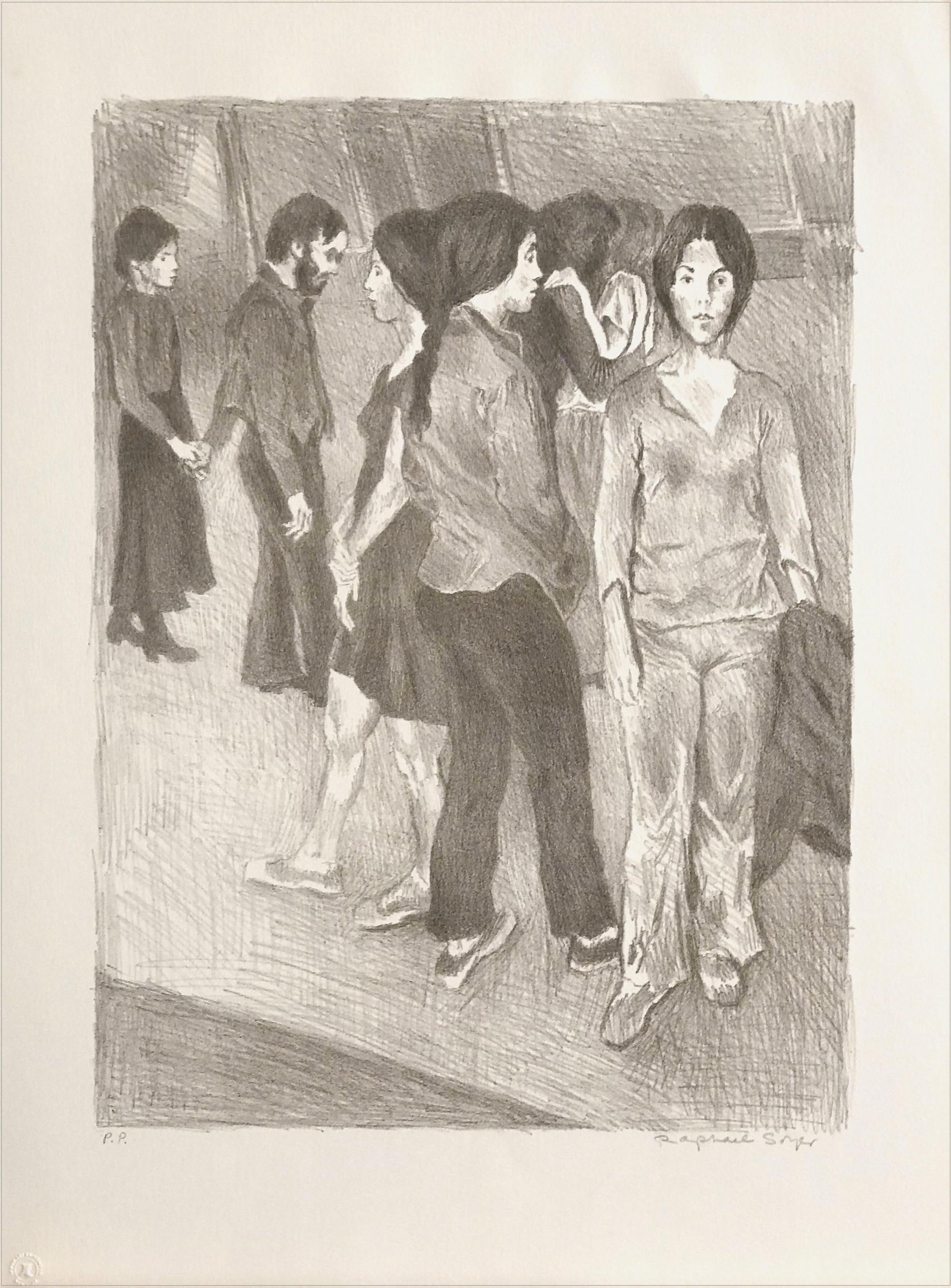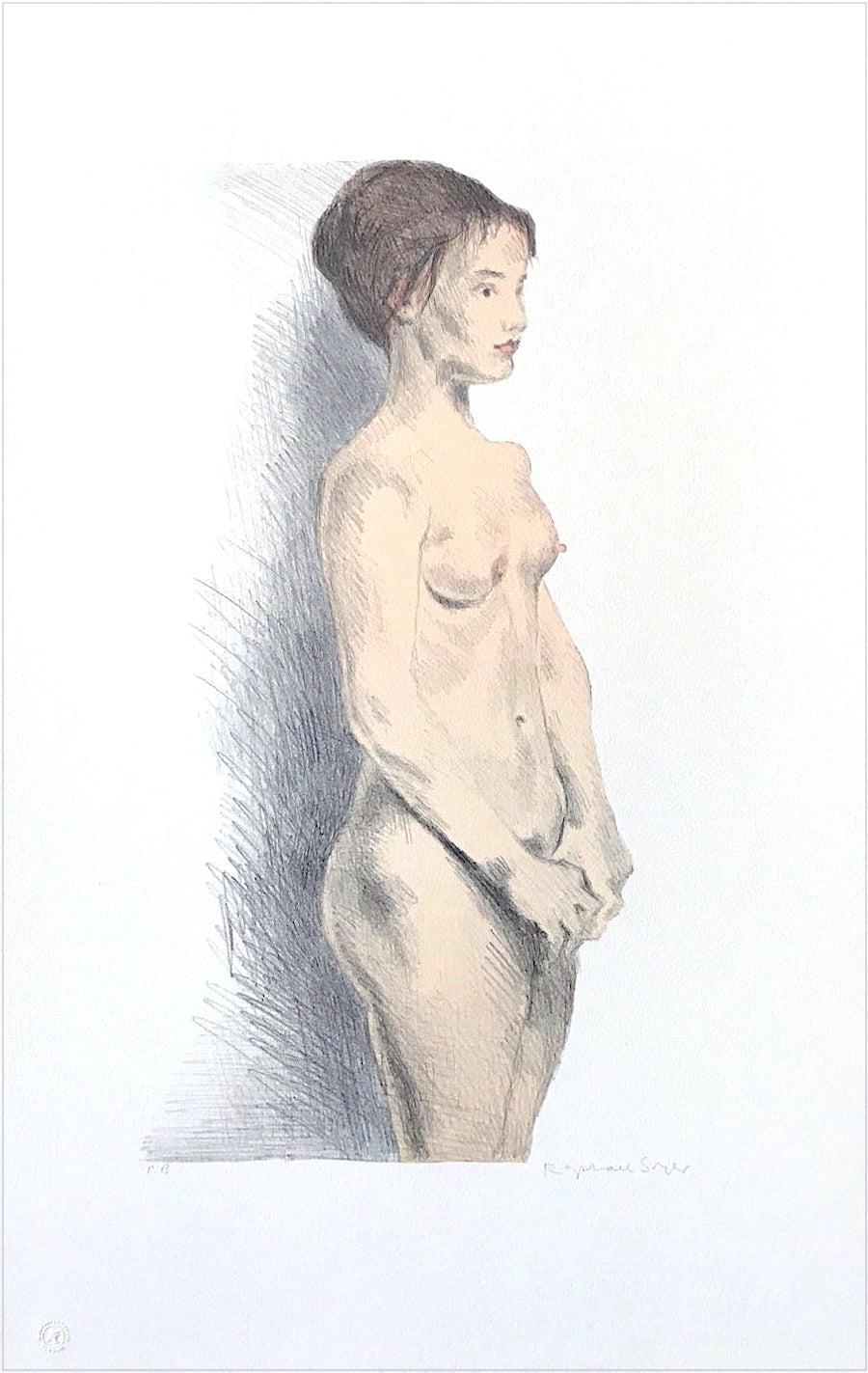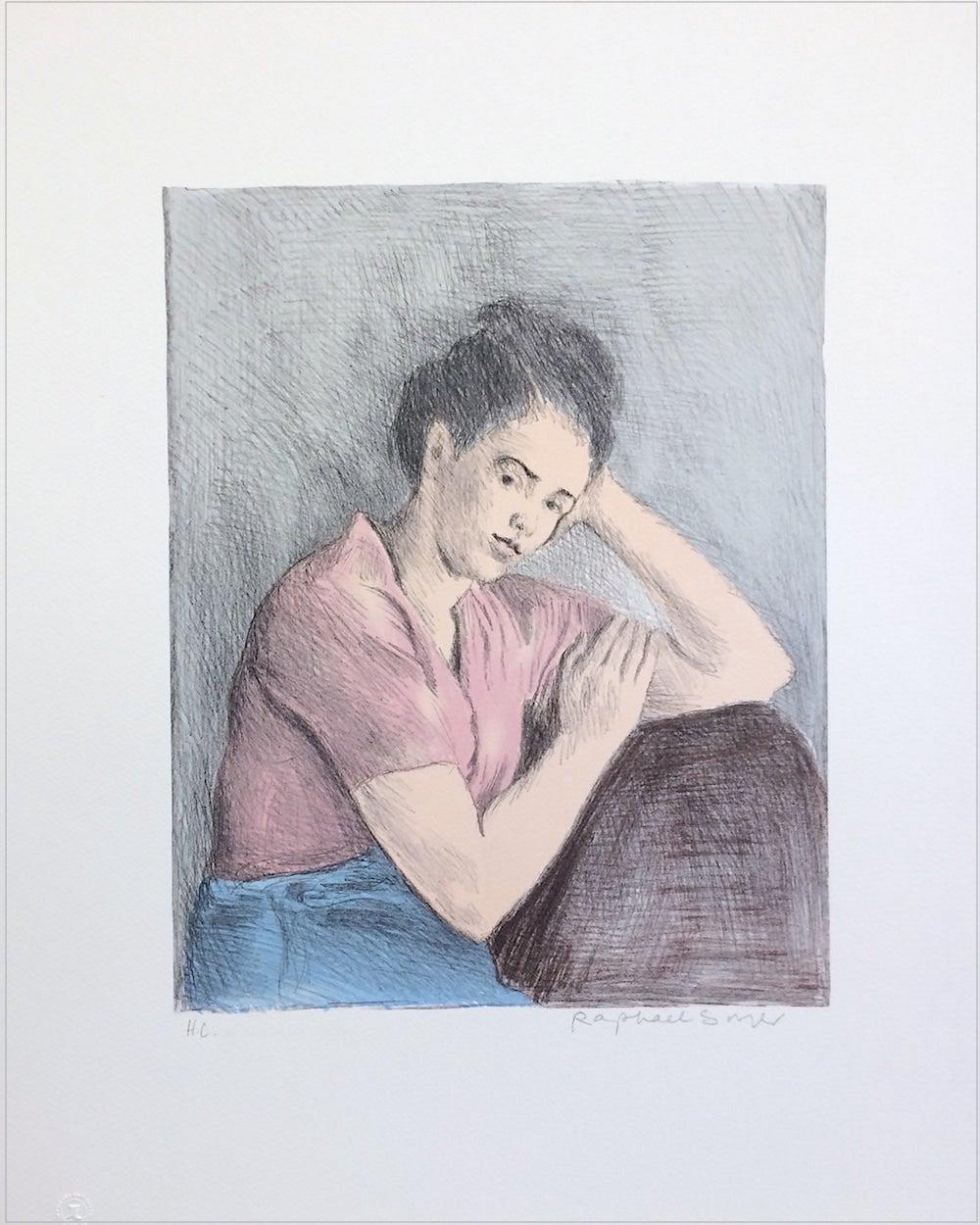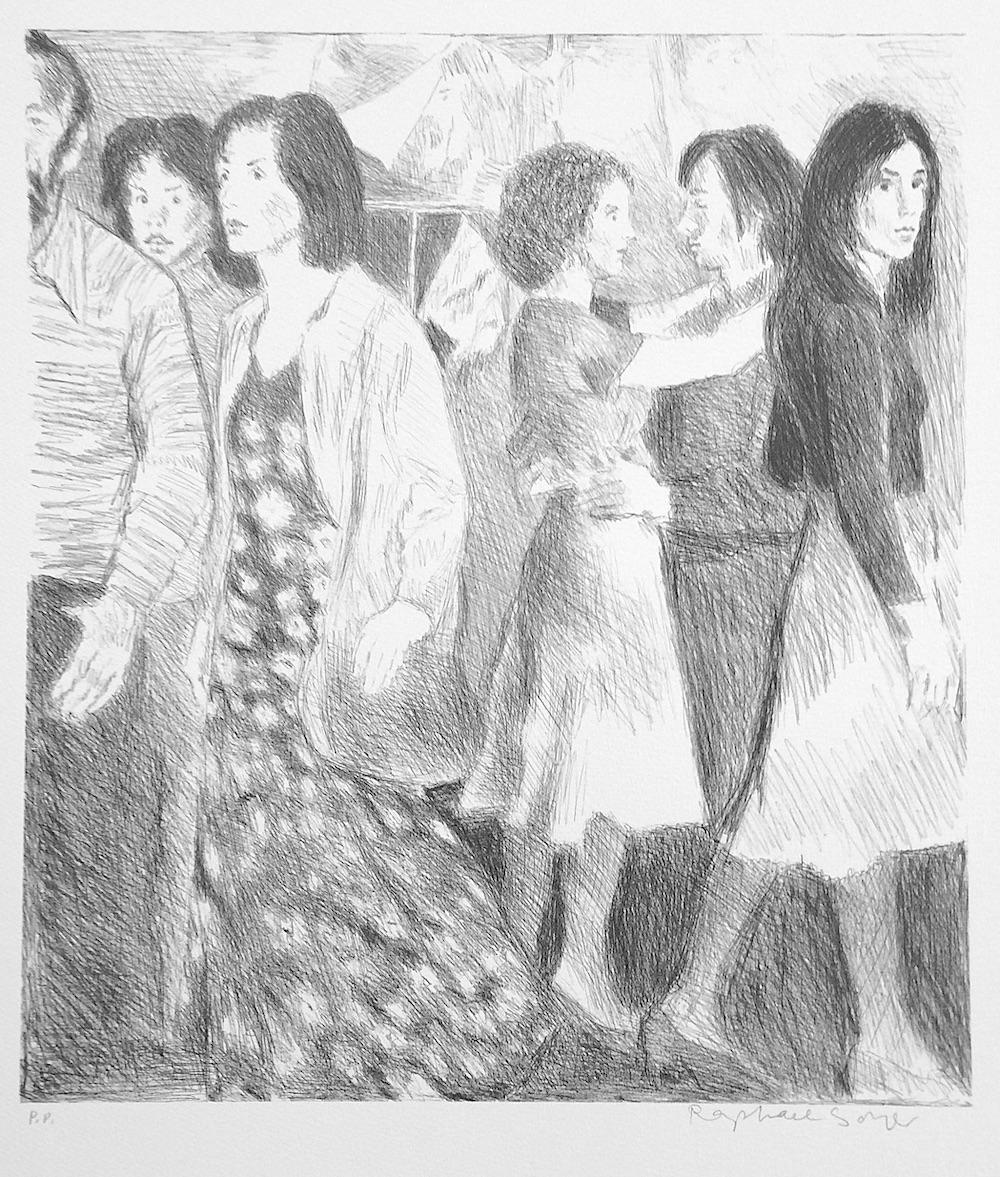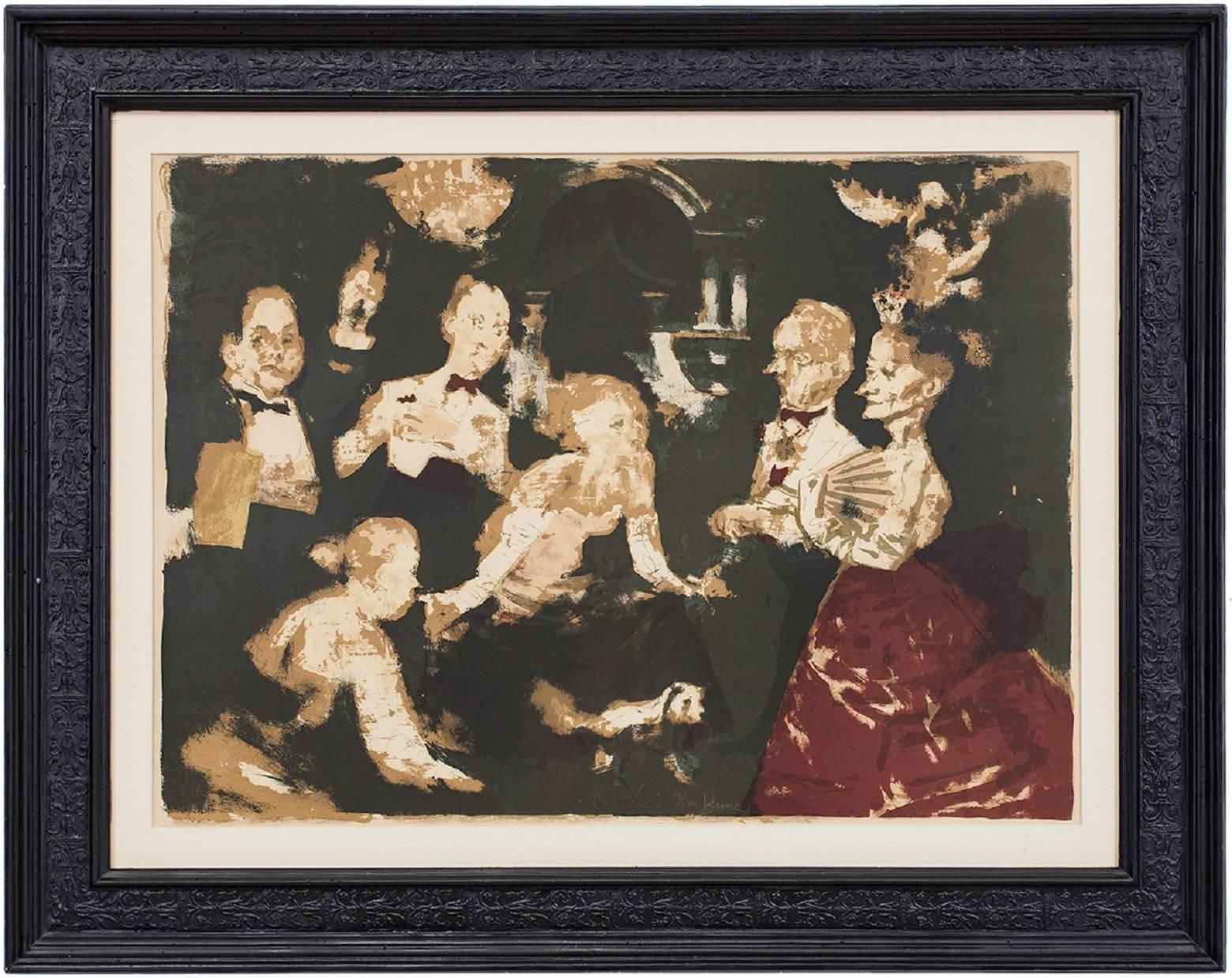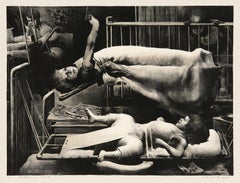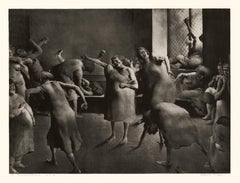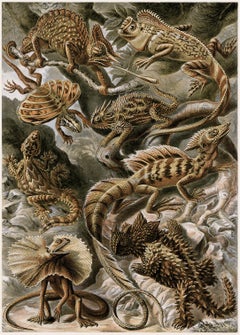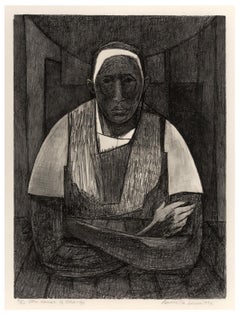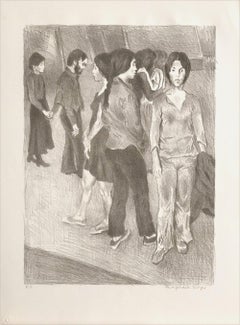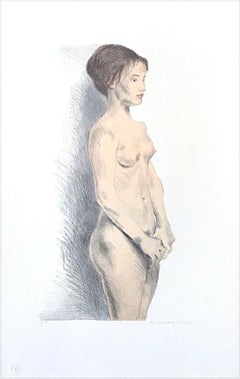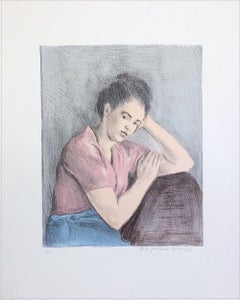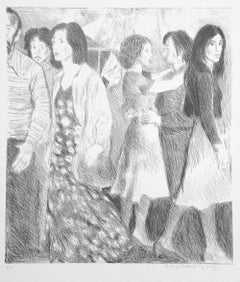Items Similar to 'Four Women' from the suite 'The Beggar's Opera'
Want more images or videos?
Request additional images or videos from the seller
1 of 3
Mariette Lydis'Four Women' from the suite 'The Beggar's Opera'1937
1937
On Hold
$550
On Hold
£416.73
On Hold
€478.16
On Hold
CA$773.94
On Hold
A$850.77
On Hold
CHF 447.13
On Hold
MX$10,331.47
On Hold
NOK 5,577.79
On Hold
SEK 5,284.57
On Hold
DKK 3,568.66
About the Item
Mariette Lydis, 'Four Women' from the suite 'The Beggar's Opera', lithograph, edition unknown but small, 1937. Signed in pencil; initialed in the stone, lower left. A fine impression, on grey wove paper, with full margins, in excellent condition. Archivally matted to museum standards, unframed.
Image size 10 3/8 x 6 13/16 inches (264 x 173 mm); sheet size 13 1/4 x 9 1/8 inches (337 x 232 mm).
Included in the portfolio of fifteen lithographs illustrating 'The Beggar's Opera' by John Gay; published by The Limited Editions Club, New York, 1937.
Impressions of this work are held in the following collections: Art Institute of Chicago, British Museum, Metropolitan Museum of Art, Minneapolis Institute of Art, Museum of Fine Arts, Boston, University of Texas, Austin.
ABOUT THE ARTIST
Mariette Lydis (1887-1970) was a renowned Austrian-Argentine painter, illustrator, and printmaker whose works encompassed a range of mediums and styles, often exploring themes of femininity, intimacy, and mysticism. Born in Vienna, Austria, in 1887, her life was characterized by artistic passion, personal reinvention, and adaptation to the global upheaval of the early 20th century.
Lydis grew up in a cultured, intellectual environment that nurtured her artistic inclinations. By the 1920s, as a self-taught artist, she began exhibiting her work in Europe and gained recognition for her delicate, emotionally evocative style that frequently blended realism and surrealism.
In 1925, Lydis traveled to France, where she became immersed in the art circles of Paris. She quickly earned a reputation as a talented painter and illustrator. Her first recorded illustration was for "The Cloak of Dreams" by Béla Balázs, followed by her illustrations for "Le Petit Jésus" by Joseph Delteil. Lydis later became a member of the Salon d’Autonne and held a solo exhibit at the Galerie Bernheim. She continued to illustrate works for notable authors such as Henry de Montherlant, Paul Valéry, Pierre Louÿs, Paul Verlaine, and Jules Supervielle, which solidified her status as a promising avant-garde artist.
With the rise of Nazism in Europe, Lydis, who was of Jewish descent, fled to South America in 1939. She settled in Buenos Aires, Argentina, where she joined the Argentine Academy of Fine Arts and actively contributed to the progressive art scene. Her time in Buenos Aires marked a prolific period of creation, including portraits, book illustrations, and prints. She gained recognition as a master of lithography, producing detailed, intimate works that resonated with international audiences. Throughout most of the 1940s, she collaborated with her then-husband, Giuseppe Govone, on various publications, including "Le Trefle à Quatre Feuilles: Ou La Clef Du Bonheur." In 1948, Lydis returned to France to work with French publishers, illustrating the writings of Guy de Maupassant, Colette, Baudelaire, Rimbaud, Bella Moerel, and Henry James. She eventually returned to Buenos Aires due to the political tensions of the Cold War and continued her artistic endeavors there until her death in 1970.
Lydis's art captured the complex emotional landscapes of her subjects, particularly women, children, and nudes. Influenced by the Japanese artist Tsuguharu Foujita, her work often combined elements of symbolism with modernist influences. In addition to her mainstream published work, Lydis was known for her lithographic depictions celebrating lesbian and bisexual relationships. Critics of this genre described it as “perverse,” drawing comparisons to the works of the Polish painter Tamara de Lempicka.
Today, her works are exhibited in prestigious institutions, including the Art Institute of Chicago, the British Museum in London, the Fogg Art Museum at Harvard University, the Getty Museum, the Metropolitan Museum of Art, the Minneapolis Institute of Art, the National Gallery of Canada, Penn State University, the U.S. Library of Congress, and the Victoria and Albert Museum in London.
- Creator:Mariette Lydis (1887 - 1970, Austrian)
- Creation Year:1937
- Dimensions:Height: 10.38 in (26.37 cm)Width: 6.82 in (17.33 cm)
- Medium:
- Movement & Style:
- Period:
- Condition:
- Gallery Location:Myrtle Beach, SC
- Reference Number:Seller: 1039751stDibs: LU53239141462
About the Seller
5.0
Recognized Seller
These prestigious sellers are industry leaders and represent the highest echelon for item quality and design.
Platinum Seller
Premium sellers with a 4.7+ rating and 24-hour response times
Established in 1995
1stDibs seller since 2016
321 sales on 1stDibs
Typical response time: 1 hour
Associations
International Fine Print Dealers Association
- ShippingRetrieving quote...Shipping from: Myrtle Beach, SC
- Return Policy
Authenticity Guarantee
In the unlikely event there’s an issue with an item’s authenticity, contact us within 1 year for a full refund. DetailsMoney-Back Guarantee
If your item is not as described, is damaged in transit, or does not arrive, contact us within 7 days for a full refund. Details24-Hour Cancellation
You have a 24-hour grace period in which to reconsider your purchase, with no questions asked.Vetted Professional Sellers
Our world-class sellers must adhere to strict standards for service and quality, maintaining the integrity of our listings.Price-Match Guarantee
If you find that a seller listed the same item for a lower price elsewhere, we’ll match it.Trusted Global Delivery
Our best-in-class carrier network provides specialized shipping options worldwide, including custom delivery.More From This Seller
View All'Children's Ward' — Socially-Conscious Realism
By Robert Riggs
Located in Myrtle Beach, SC
Robert Riggs, 'Children's Ward', 2-color lithograph, c. 1940, edition c. 50, Beall 11, Bassham 76. Signed, titled, and numbered '14' in pencil. Signed in the stone, lower right. A su...
Category
1940s Realist Figurative Prints
Materials
Lithograph
'Psychopathic Ward' — Socially-Conscious Realism
By Robert Riggs
Located in Myrtle Beach, SC
Robert Riggs, 'Psychopathic Ward', 2-color lithograph, c. 1940, edition c. 50, Beall 60, Bassham 78. Signed, titled, and numbered '14' in pencil. Signed in the stone, lower right. A ...
Category
1940s Realist Figurative Prints
Materials
Lithograph
Art Forms in Nature (Plate 79 - Basiliscus) — 1899 Celebration of Nature
Located in Myrtle Beach, SC
Ernst Haeckel, 'Art Forms in Nature' (Plate 79 - Basiliscus), offset lithograph, 1899. Signed and titled in typeset, upper left. Titled 'Tafel 79 — Basi...
Category
1890s Realist Figurative Prints
Materials
Lithograph
The House of Shango — African American artist
By Samella Lewis
Located in Myrtle Beach, SC
Samella Sanders Lewis, 'The House of Shango', lithograph, 1992, edition 60. Signed, dated, titled, and numbered '31/60' in pencil. A superb, richly-inked impression, on Arches cream wove paper; the full sheet with margins (1 1/4 to 3 1/2 inches), in excellent condition. Image size 24 x 18 inches (610 x 457 mm); sheet size 30 inches x 22 1/4 inches (762 x 565 mm). Archivally matted to museum standards, unframed.
ABOUT THIS WORK
“The title of this piece is an unmistakable harkening to African roots. Shango is a religious practice with origins in Yoruba (Nigerian) belief, deifying a god of thunder by the same name. Shango has been adopted in the Caribbean, most notably in Trinidad and Tobago, a fact that underscores the importance of transnationalism to Samella Lewis’s piece. Her work often grapples with issues of race in the U.S., and The House of Shango is no exception. Through a reliance on the gradual transformation of Shango—one that took place across continents and time—Lewis’s piece forms a powerful link between black Americans and their African and Caribbean counterparts. The figure depicted in the piece appears to emerge, quite literally, from the house of Shango. Given the roots and transformative process of the religion, The House of Shango can draw attention to the historical intersections to which black American culture is indebted.” —Laura Woods, Scripps College, Ruth Chander Williamson Gallery, Collection Highlights, 2018
ABOUT THE ARTIST
Samella Lewis’ lifelong career as an artist, art historian, critic, curator, collector, and advocate of African American art has helped empower generations of artists in the United States and worldwide, earning her the designation “the Godmother of African American art.”
Born and raised in Jim Crow era New Orleans, Lewis began her art education at Dillard University in 1941, transferring to Hampton University in Virginia, where she earned her B. A. and master's degrees. She completed her master's and a doctorate in art history and cultural anthropology at Ohio State University in 1951, becoming the first female African American to earn a doctorate in fine art and art history.
Lewis taught art at Morgan State University while completing her doctorate. She became the first Chair of the Fine Arts Department at Florida A&M University in 1953. That same year Lewis also became the first African American to convene the National Conference of African American artists held at Florida A&M University. She was a professor at the State University of New York, California State University, Long Beach, and at Scripps College in Claremont, California. Lewis co-founded, with Bernie Casey, the Contemporary Crafts Gallery in Los Angeles in 1970. In 1973, she served on the selection committee for the exhibition BLACKS: USA: 1973 held at the New York Cultural Center.
Samella Lewis's 1969 catalog 'Black Artists on Art', featured accomplished black artists typically overlooked in mainstream art galleries. She said of the book, "I wanted to make a chronology of African American artists, and artists of African descent, to document our history. The historians weren't doing it. It was really about the movement."
From the 1960s through the 1970s, her work, which included lithographs, linocuts, and serigraphs, reflected her concerns with the values of human dignity, democracy, and freedom of expression. Between 1969 and 70, Lewis and E.J. Montgomery were consultants for a groundbreaking exhibition at the Oakland Public L designed to create greater awareness of African American history and art.
Lewis was the founder of the International Review of African American Art in 1975. In 1976, she founded the Museum of African-American Art with a group of artistic, academic, business, and community leaders in Los Angeles, California. Lewis, the museum’s senior curator, organized exhibitions and developed new ways of educating the public about African American art. She celebrated African American art as an 'art of experience’ inspired by the artists’ lives. And she espoused the concept of African American art as an 'art of tradition', urging museums to explore the African roots of African American art. In 1984, Lewis produced an extensive monograph on Elizabeth Catlett, her beloved mentor at Dillard University.
Lewis has been collecting art since 1942, focusing primarily on the WPA era and work created during the Harlem Renaissance. Pieces from her collection were acquired by the Hampton University Museum in Virginia, the world’s earliest collection of African American fine art...
Category
1990s Realist Figurative Prints
Materials
Lithograph
'Bacchus Cumampelo' — 18th Century Classical Italian Realism
Located in Myrtle Beach, SC
Giovanni Domenico Campiglia, 'Bacchus Cumampelo', engraving, 1734, edition unknown. Signed 'Dom. Campiglia del.' in the plate, lower left. Engraving by Gabbugiani, after the original...
Category
1730s Realist Nude Prints
Materials
Engraving
'Dei Praestitis Signumexaere' — 18th Century Classical Italian Realism
Located in Myrtle Beach, SC
Giovanni Domenico Campiglia, 'Dei Praestitis Signumexaere' (God's Providence Signumexaere), engraving, 1734, edition unknown. Signed 'Dom. Campiglia del.' in the plate, lower left. E...
Category
1730s Realist Nude Prints
Materials
Engraving
You May Also Like
GATHERING Signed Stone Lithograph, NYC Group Portrait Drawing, Brown
By Raphael Soyer
Located in Union City, NJ
GATHERING is an original hand drawn stone lithograph by Raphael Soyer, the renowned Russian-born American realist painter, draftsman, and printmaker. Hand proofed and printed in 1977...
Category
1970s Realist Portrait Prints
Materials
Lithograph
STANDING NUDE Signed Lithograph, Realist Portrait Young Woman, Figure Drawing
By Raphael Soyer
Located in Union City, NJ
STANDING NUDE an original hand drawn lithograph by Raphael Soyer, the renowned Russian-born American realist painter, draftsman, and printmaker. Printed on archival Arches paper 100%...
Category
1970s Realist Nude Prints
Materials
Lithograph
YOUNG WOMAN PINK BLOUSE Signed Lithograph, Portrait Drawing, Social Realism
By Raphael Soyer
Located in Union City, NJ
YOUNG WOMAN PINK BLOUSE is an original hand drawn (not digitally or photo reproduced) limited edition lithograph by the artist Raphael Soyer - Russian/Amer...
Category
1970s Realist Portrait Prints
Materials
Lithograph
STREET SCENE Signed Lithograph, NYC Crowd Portrait Pencil Drawing, A-Line Skirts
By Raphael Soyer
Located in Union City, NJ
STREET SCENE, NYC Crowd, is an original, hand drawn lithograph by Raphael Soyer, the renowned Russian-born American realist painter, draftsman, and printmaker. Printed using traditio...
Category
1970s Realist Figurative Prints
Materials
Lithograph
STREET SCENE Signed Hand Drawn Lithograph, Young Men and Women Casual Gathering
By Raphael Soyer
Located in Union City, NJ
STREET SCENE is an original, hand drawn lithograph by Raphael Soyer, the renowned Russian-born American realist painter, draftsman, and printmaker. Printed using traditional lithogra...
Category
1970s Realist Figurative Prints
Materials
Lithograph
Jack Levine American Modernist Social Realist WPA Artist Lithograph Dinner Party
By Jack Levine
Located in Surfside, FL
This is being sold unframed. Reception in Miami.
Born to Lithuanian Jewish parents, Levine grew up in the South End of Boston, where he observed a street life composed of European immigrants and a prevalence of poverty and societal ills, subjects which would inform his work. He first studied drawing with Harold K. Zimmerman from 1924-1931. At Harvard University from 1929 to 1933, Levine and classmate Hyman Bloom studied with Denman Ross. As an adolescent, Levine was already, by his own account, "a formidable draftsman". In 1932 Ross included Levine's drawings in an exhibition at the Fogg Art Museum at Harvard, and three years later bequeathed twenty drawings by Levine to the museum's collection. Levine's early work was most influenced by Bloom, Chaim Soutine, Georges Rouault, and Oskar Kokoschka. Along with Bloom and Karl Zerbe, he became associated with the style known as Boston Expressionism.
In 1935, shortly after its formation, Levine joined the WPA’s Federal Art Project, where he was employed intermittently until 1939. In 1937, while with the WPA, Levine painted The Feast of Pure Reason...
Category
20th Century Realist Figurative Prints
Materials
Paper, Color, Lithograph
